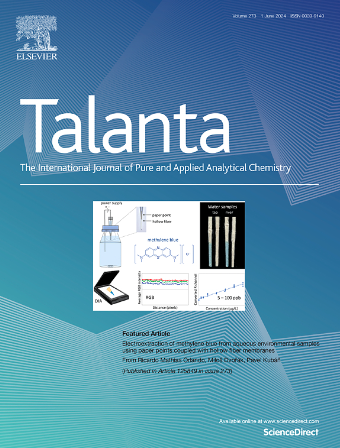Element-bridged dual-walker amplification for sensitive detection of multiple miRNAs by inductively coupled plasma mass spectrometry
IF 5.6
1区 化学
Q1 CHEMISTRY, ANALYTICAL
引用次数: 0
Abstract
The simultaneous detection of multiple microRNAs (miRNAs) is critical for advancing precise disease diagnosis and treatment strategies. Herein, we introduce a novel method for the sensitive detection of multiple miRNAs using inductively coupled plasma mass spectrometry (ICP-MS), based on a platinum group element-bridged DNAzyme dual-walker amplification system. Upon binding to target miRNAs, the terminal of DNAzyme is released, triggering two DNAzyme-mediated ribonucleotide hydrolysis walking processes driven by Mg2+. These DNAzyme-walking sequences are recycled, enabling the continuous cleavage of substrate strands. After magnetic separation, the generated element pairs are quantified by mass spectrometry, enabling simultaneous and highly sensitive detection of multiple miRNAs. The method demonstrates a linear detection range from 5 fM to 10 pM with detection limits of 1.8 fM for miRNA-21, 1.1 fM for miRNA-199a, and 1.5 fM for miRNA-499, respectively.Furthermore, the approach exhibits remarkable specificity, making it suitable for detecting miRNAs in human serum. By demonstrating such a high sensitivity and specificity, this DNA walker-based sensing strategy holds significant potential for the development of versatile platforms to detect other miRNAs at varying expression levels.

求助全文
约1分钟内获得全文
求助全文
来源期刊

Talanta
化学-分析化学
CiteScore
12.30
自引率
4.90%
发文量
861
审稿时长
29 days
期刊介绍:
Talanta provides a forum for the publication of original research papers, short communications, and critical reviews in all branches of pure and applied analytical chemistry. Papers are evaluated based on established guidelines, including the fundamental nature of the study, scientific novelty, substantial improvement or advantage over existing technology or methods, and demonstrated analytical applicability. Original research papers on fundamental studies, and on novel sensor and instrumentation developments, are encouraged. Novel or improved applications in areas such as clinical and biological chemistry, environmental analysis, geochemistry, materials science and engineering, and analytical platforms for omics development are welcome.
Analytical performance of methods should be determined, including interference and matrix effects, and methods should be validated by comparison with a standard method, or analysis of a certified reference material. Simple spiking recoveries may not be sufficient. The developed method should especially comprise information on selectivity, sensitivity, detection limits, accuracy, and reliability. However, applying official validation or robustness studies to a routine method or technique does not necessarily constitute novelty. Proper statistical treatment of the data should be provided. Relevant literature should be cited, including related publications by the authors, and authors should discuss how their proposed methodology compares with previously reported methods.
 求助内容:
求助内容: 应助结果提醒方式:
应助结果提醒方式:


